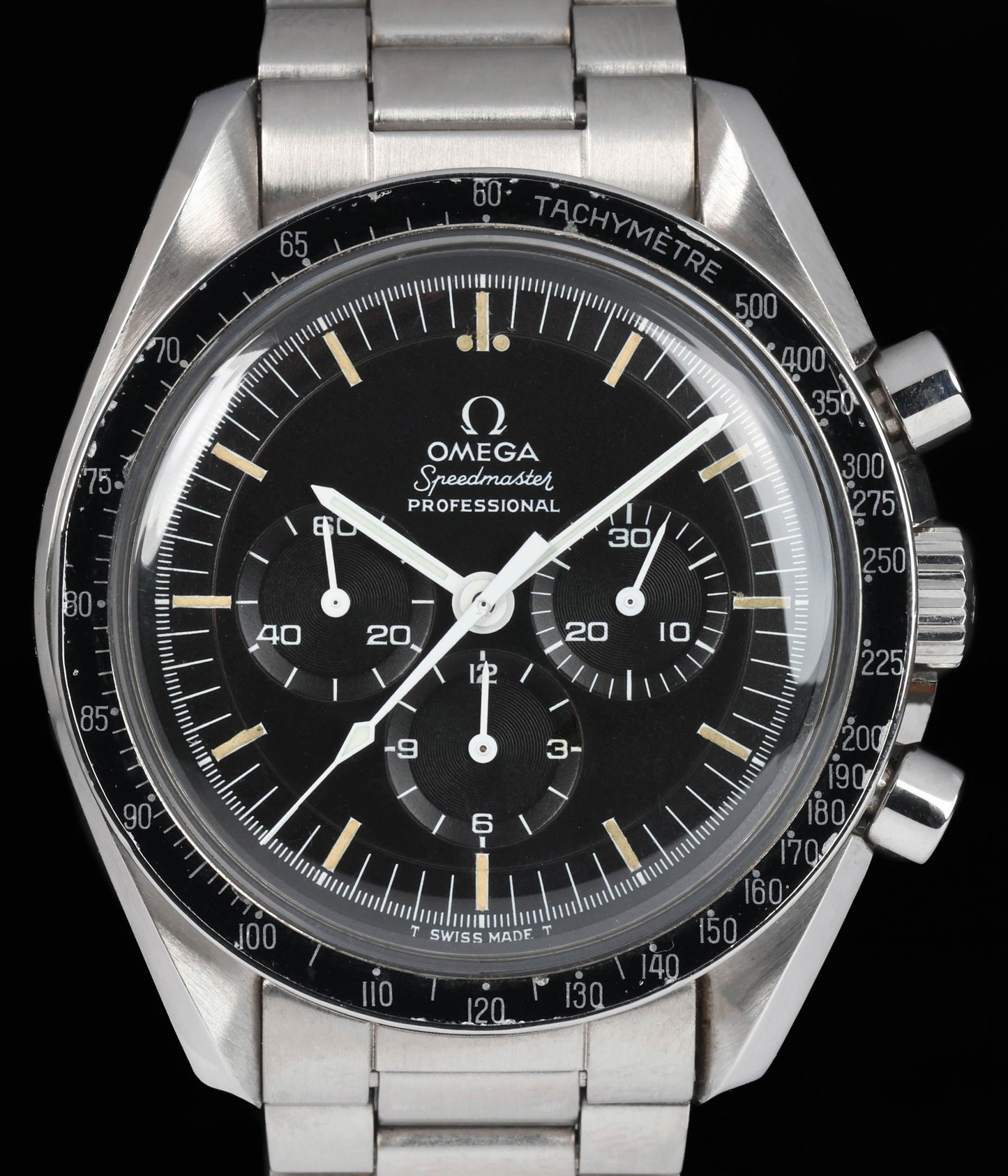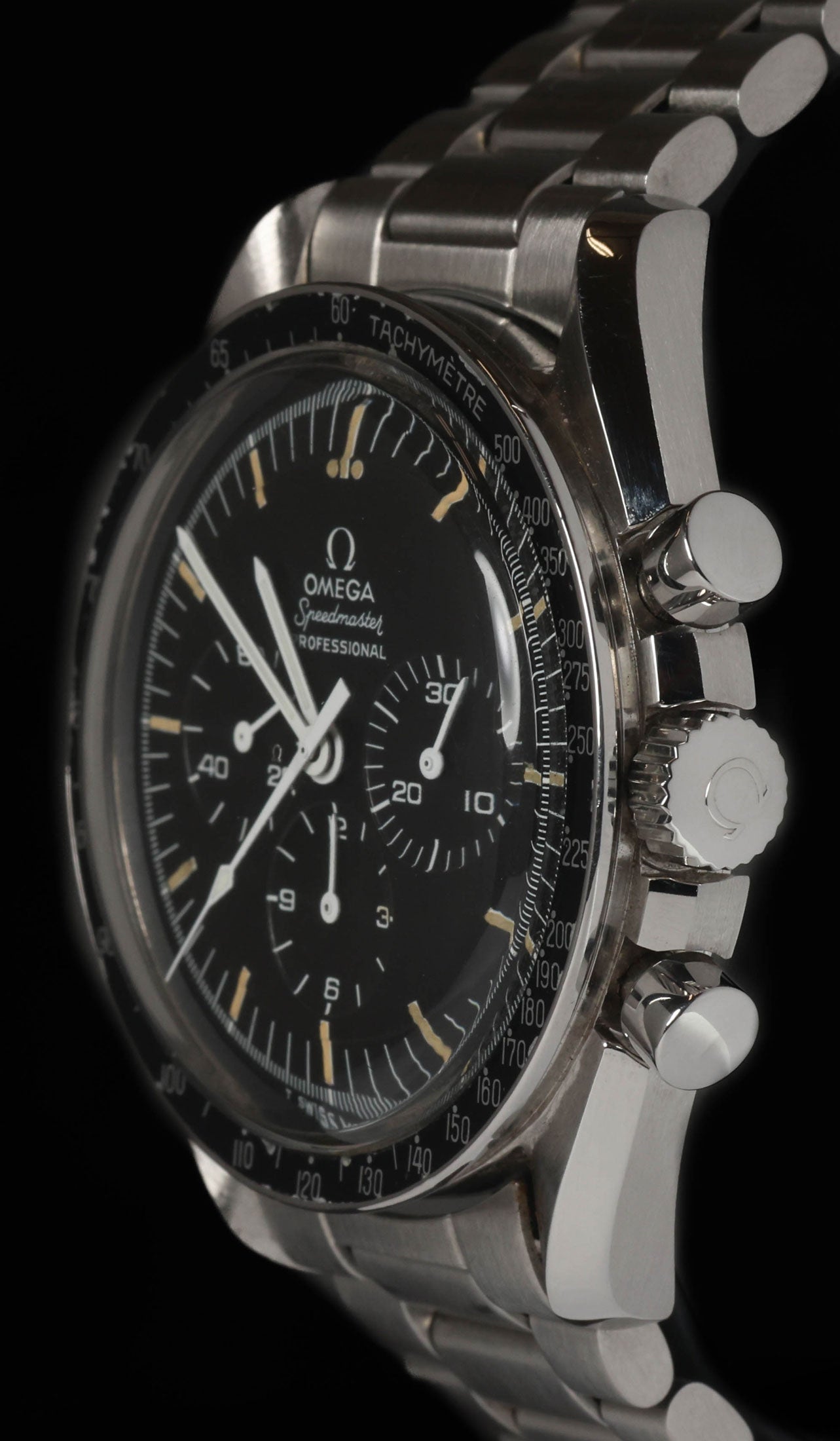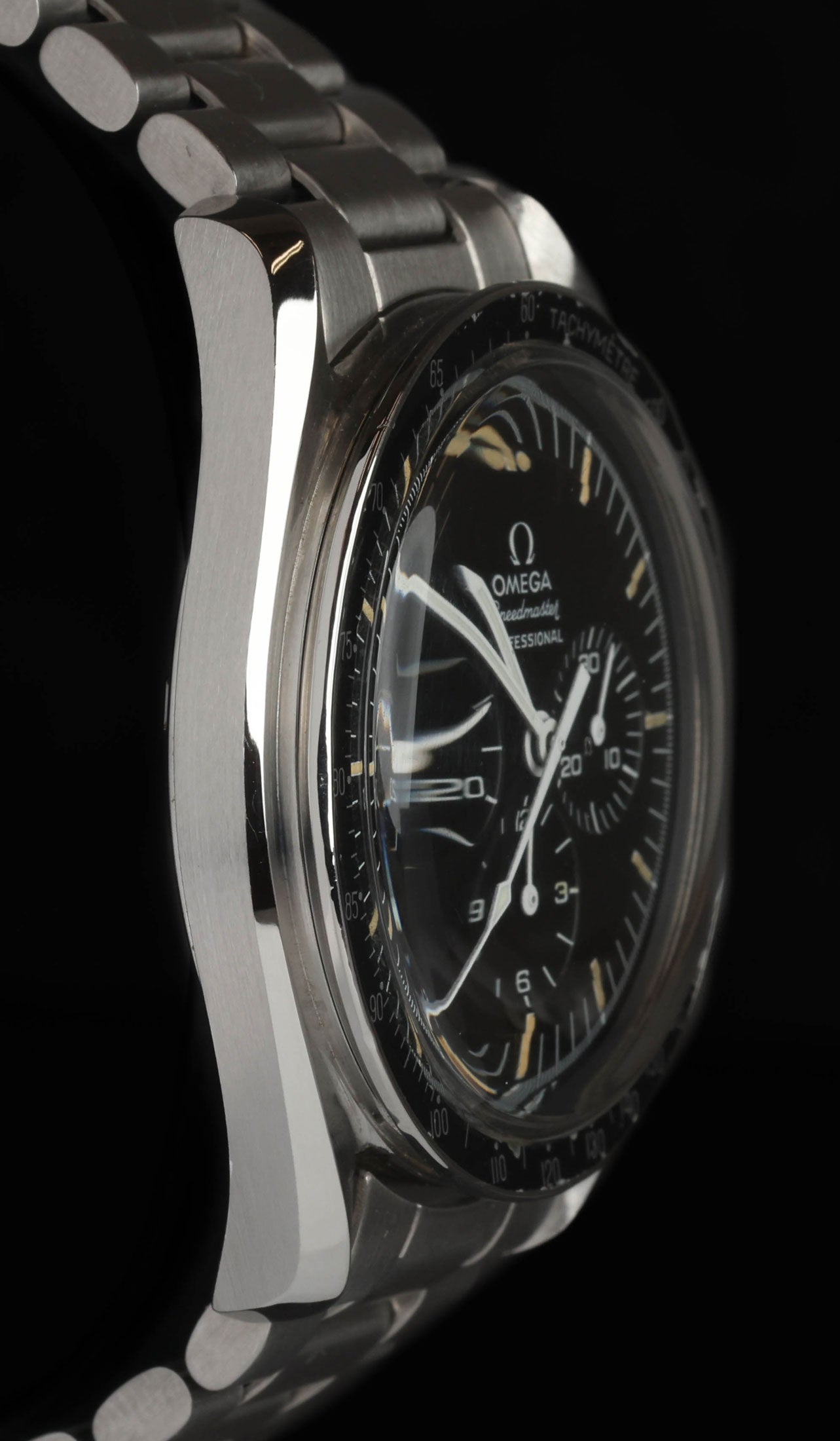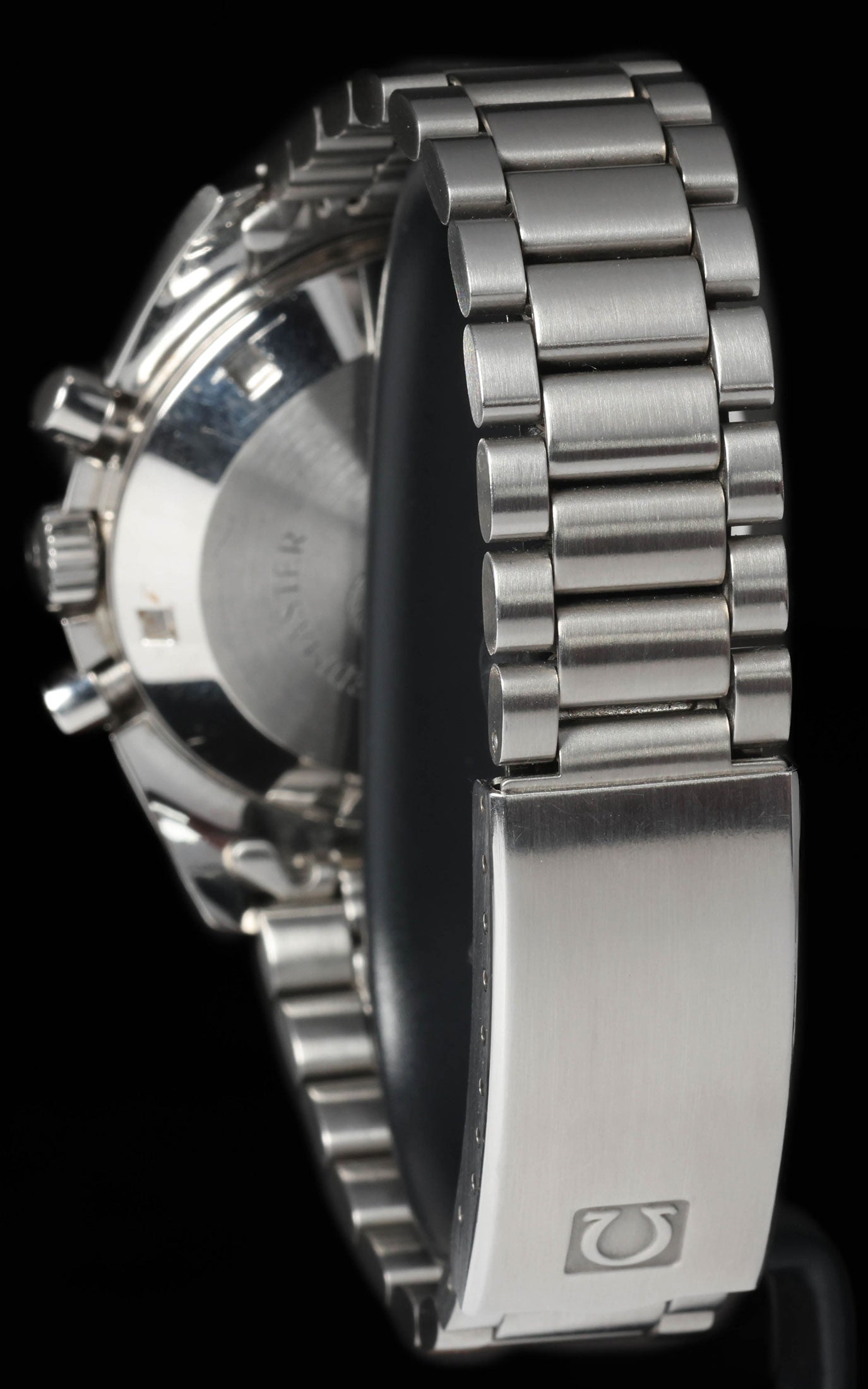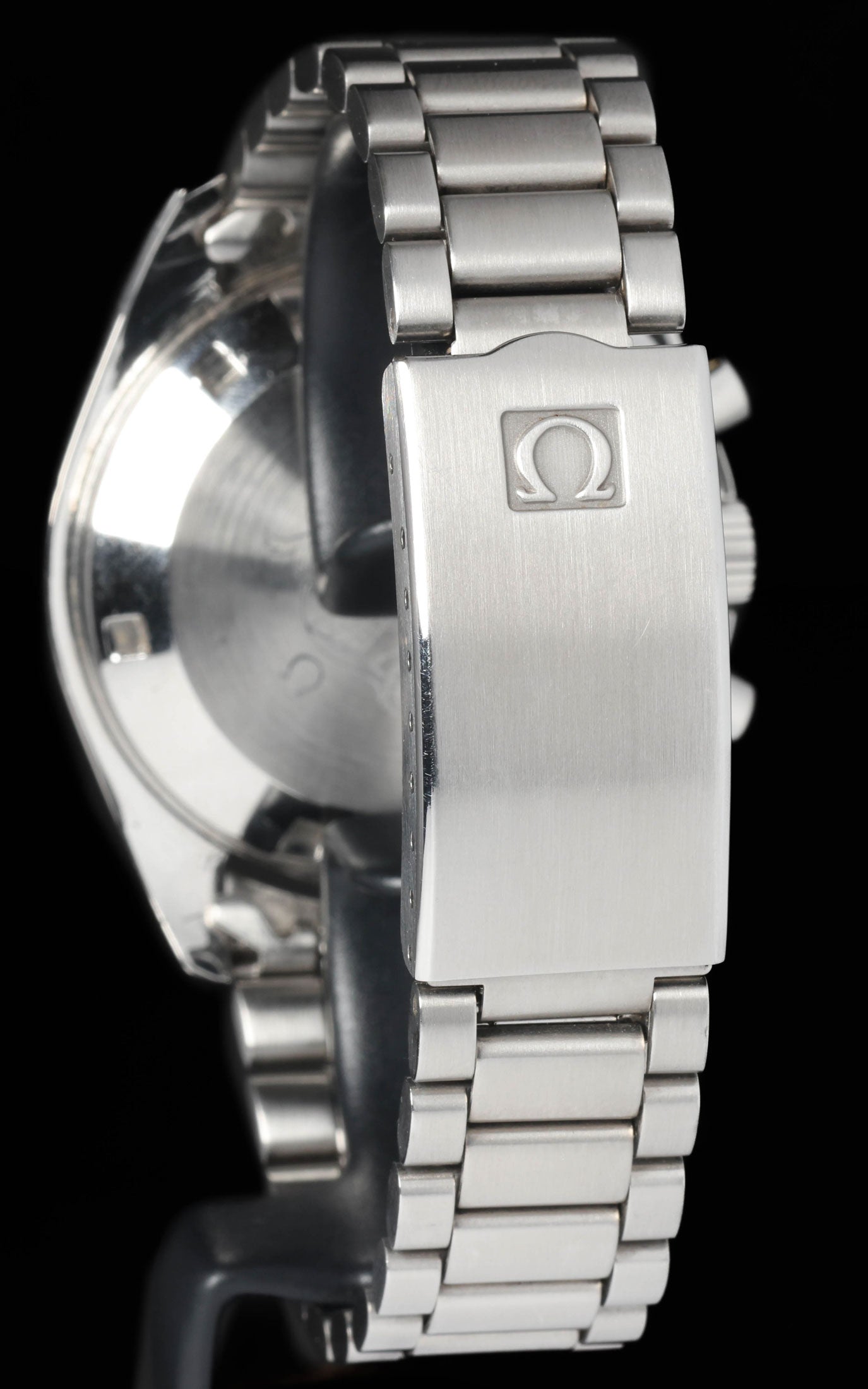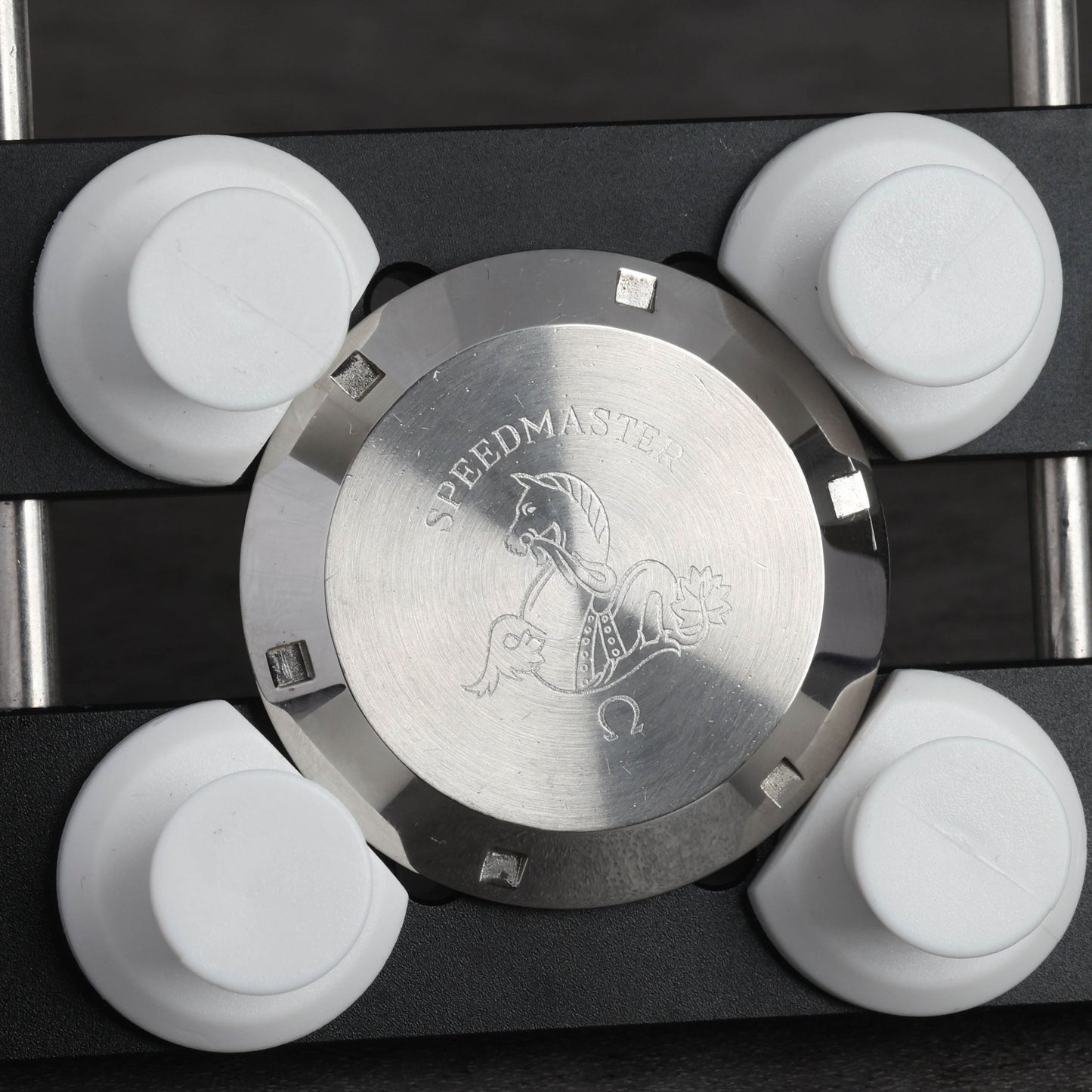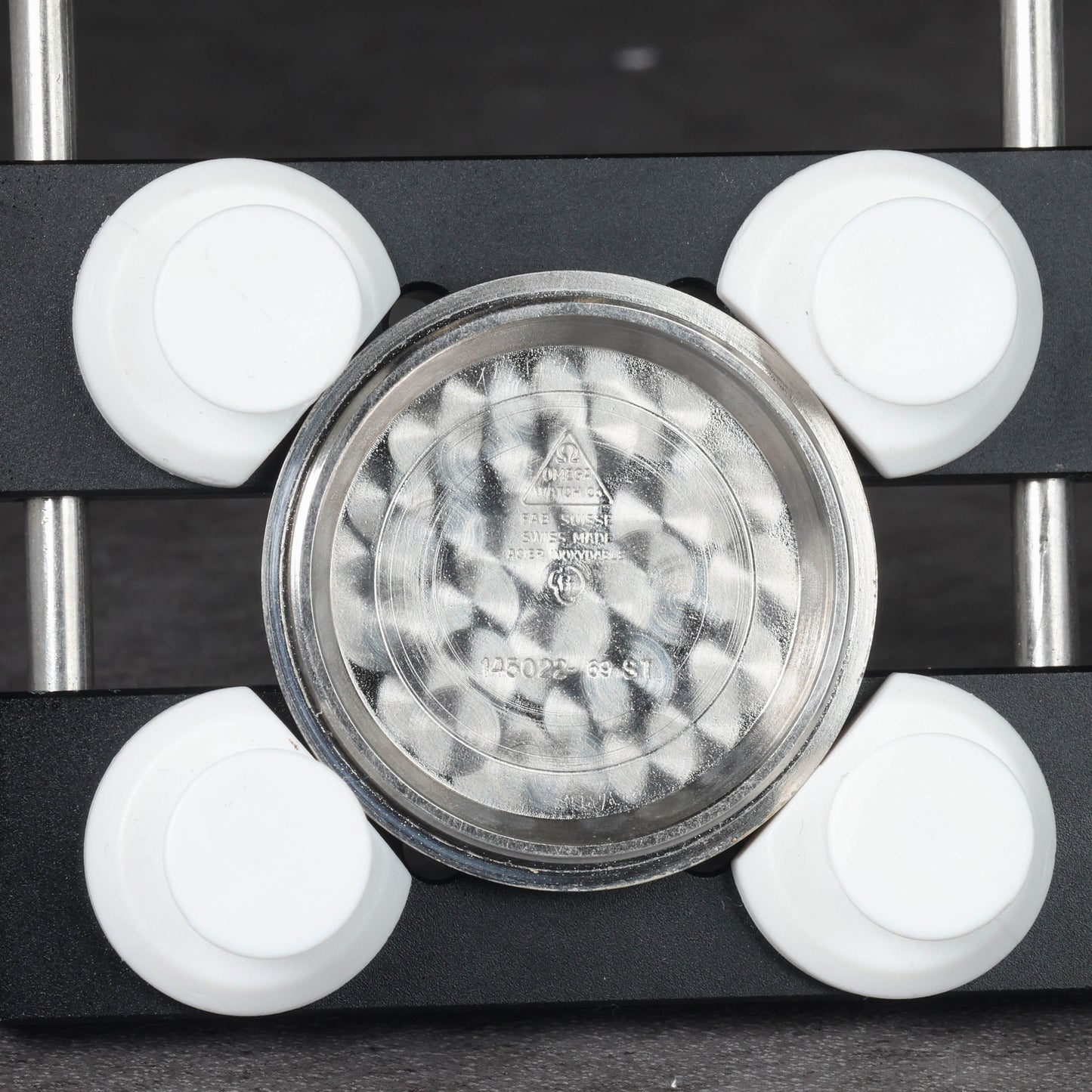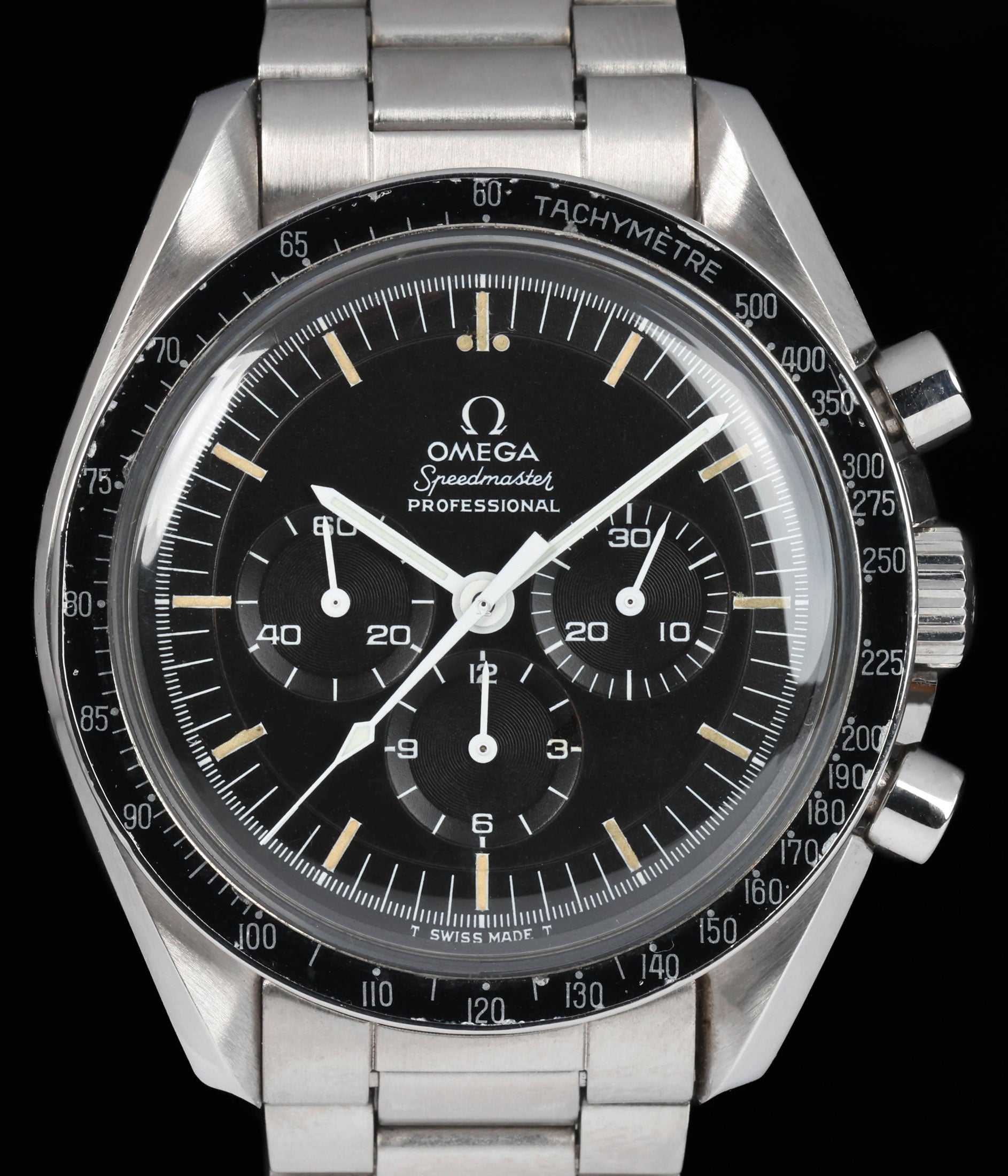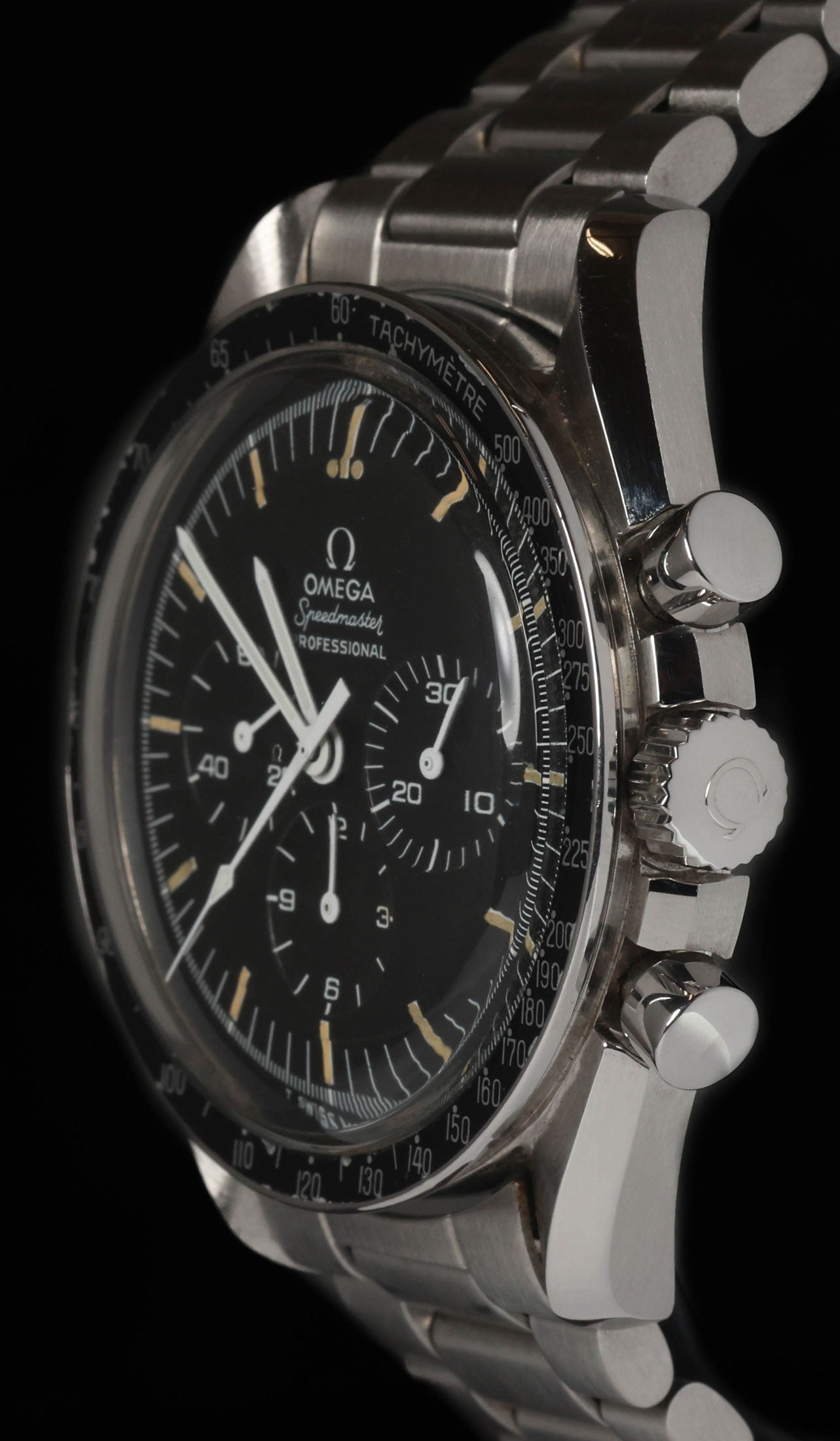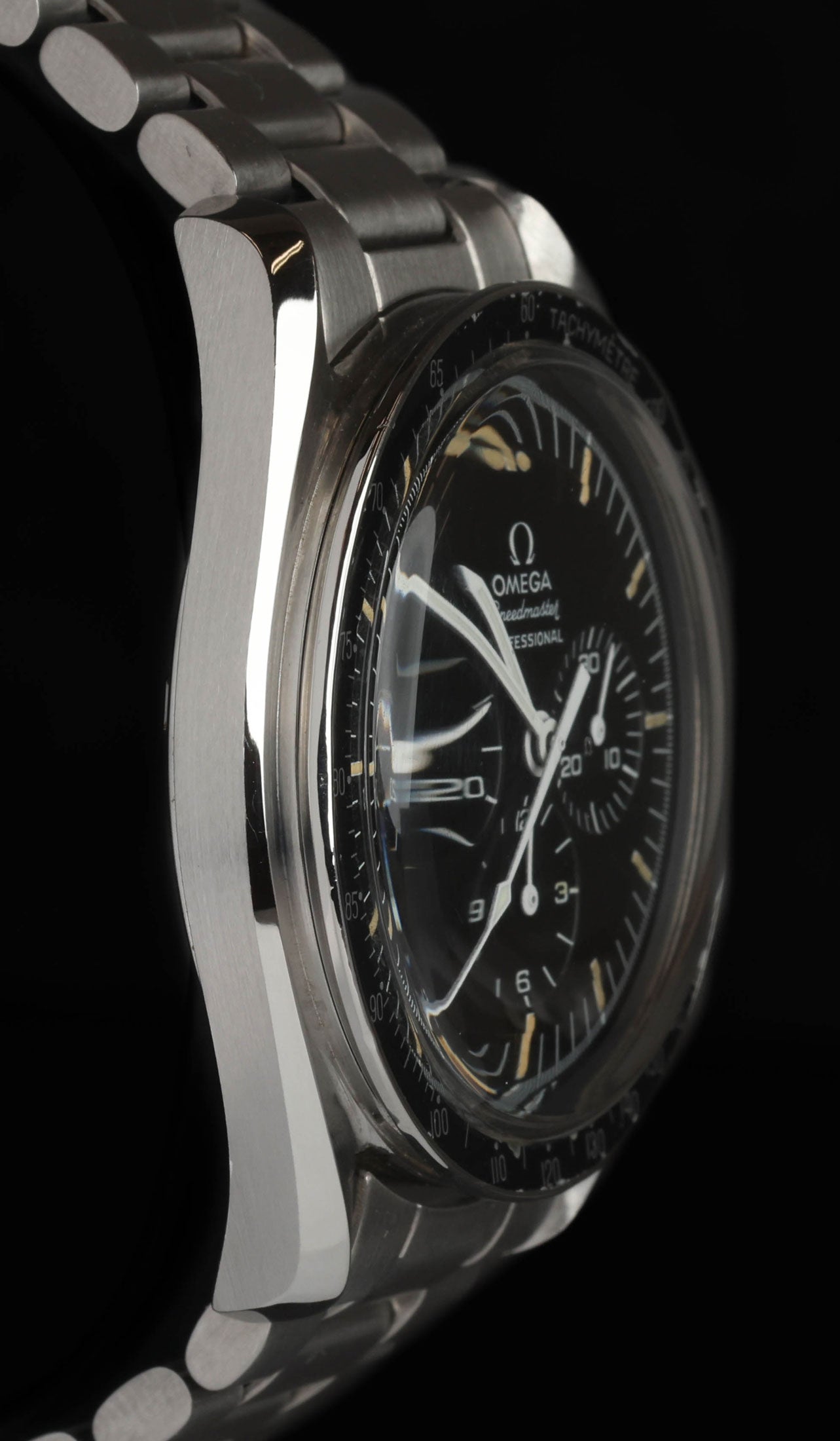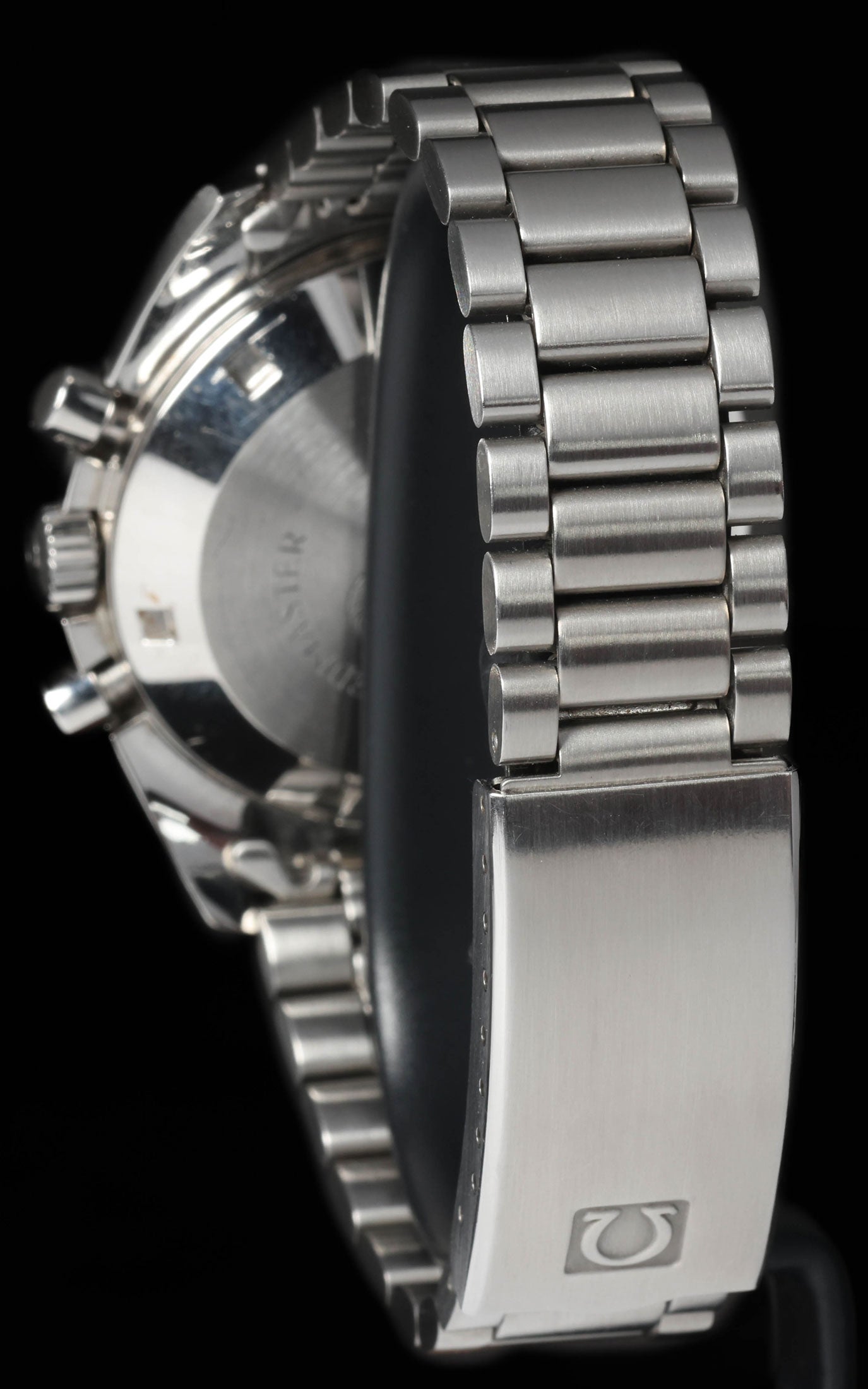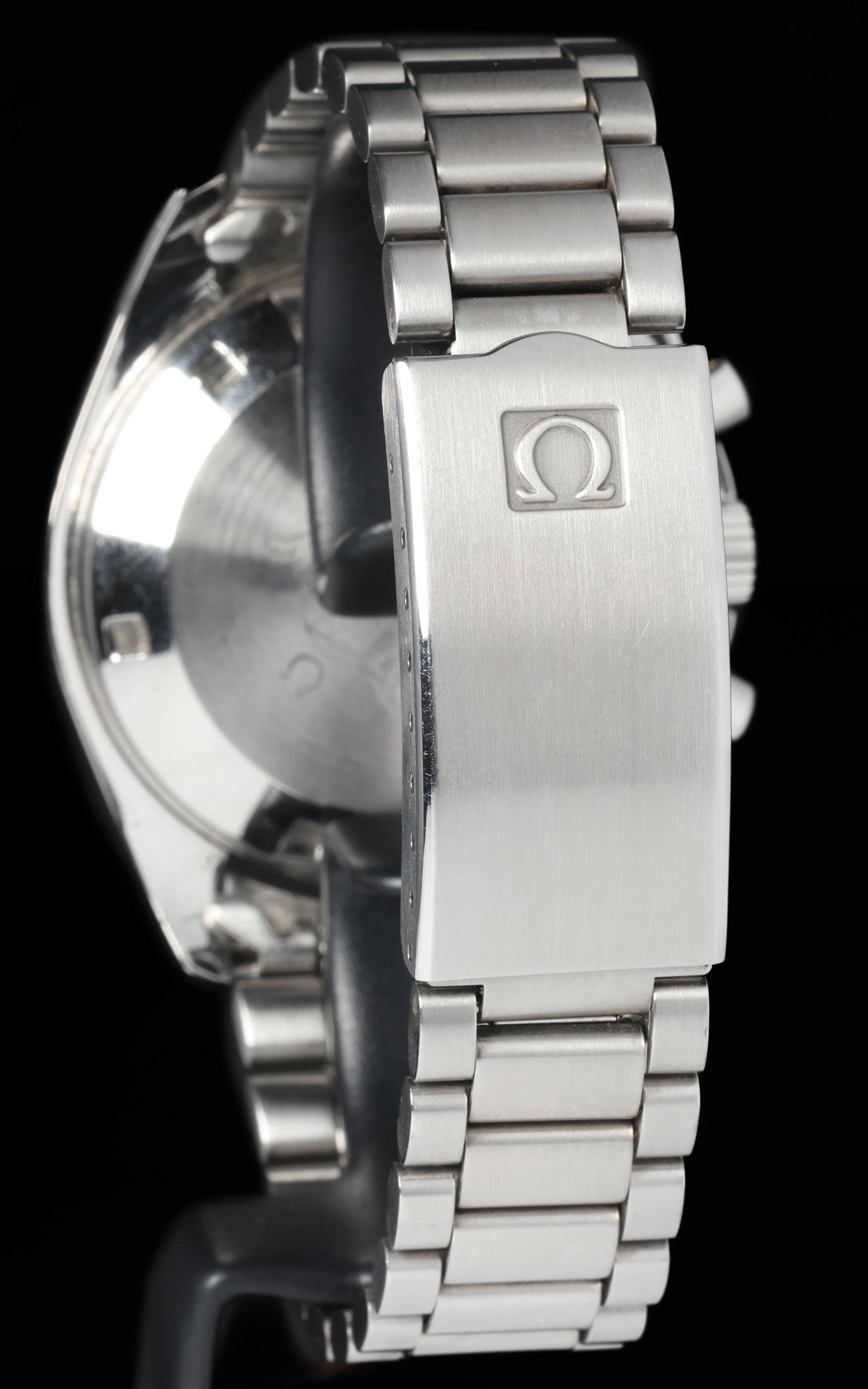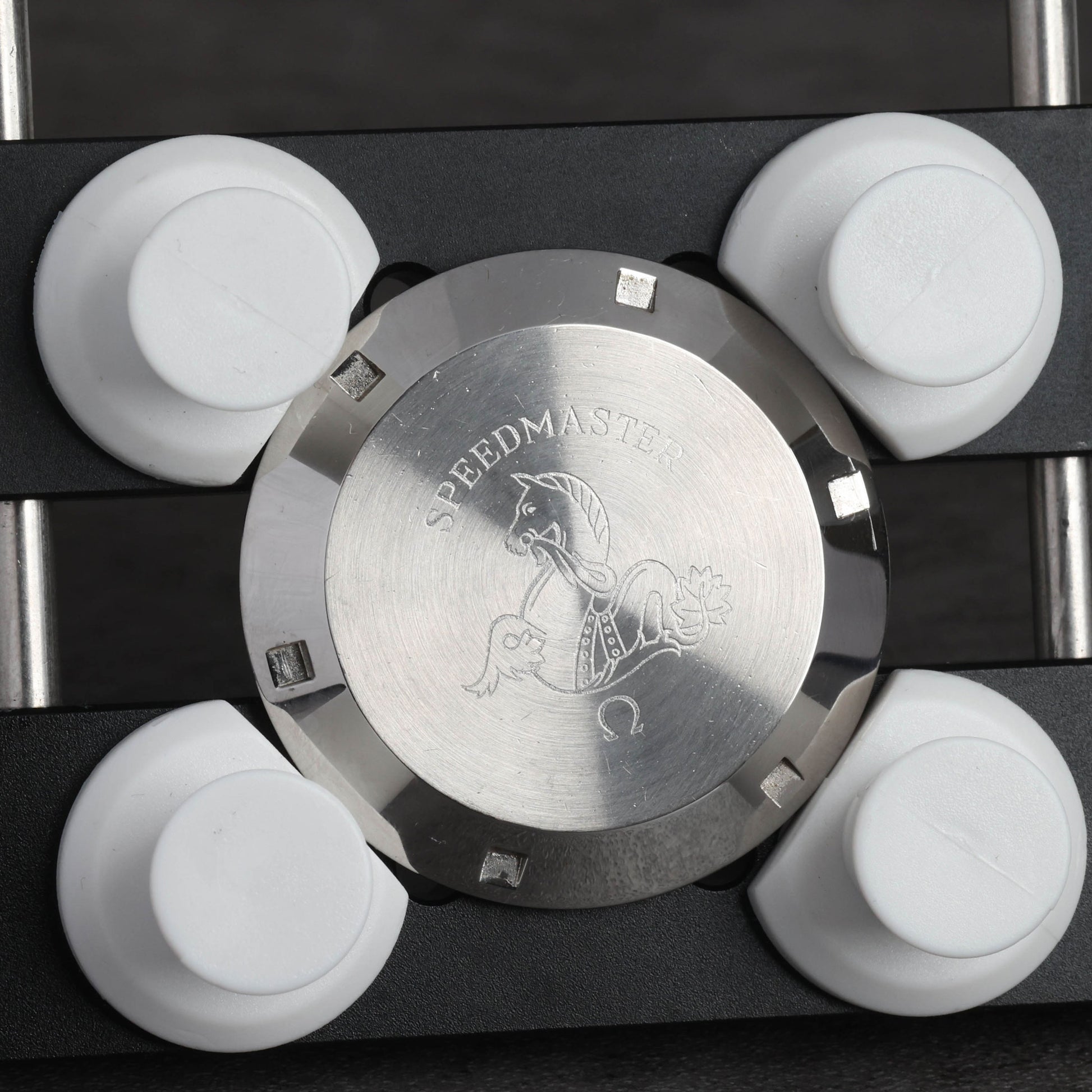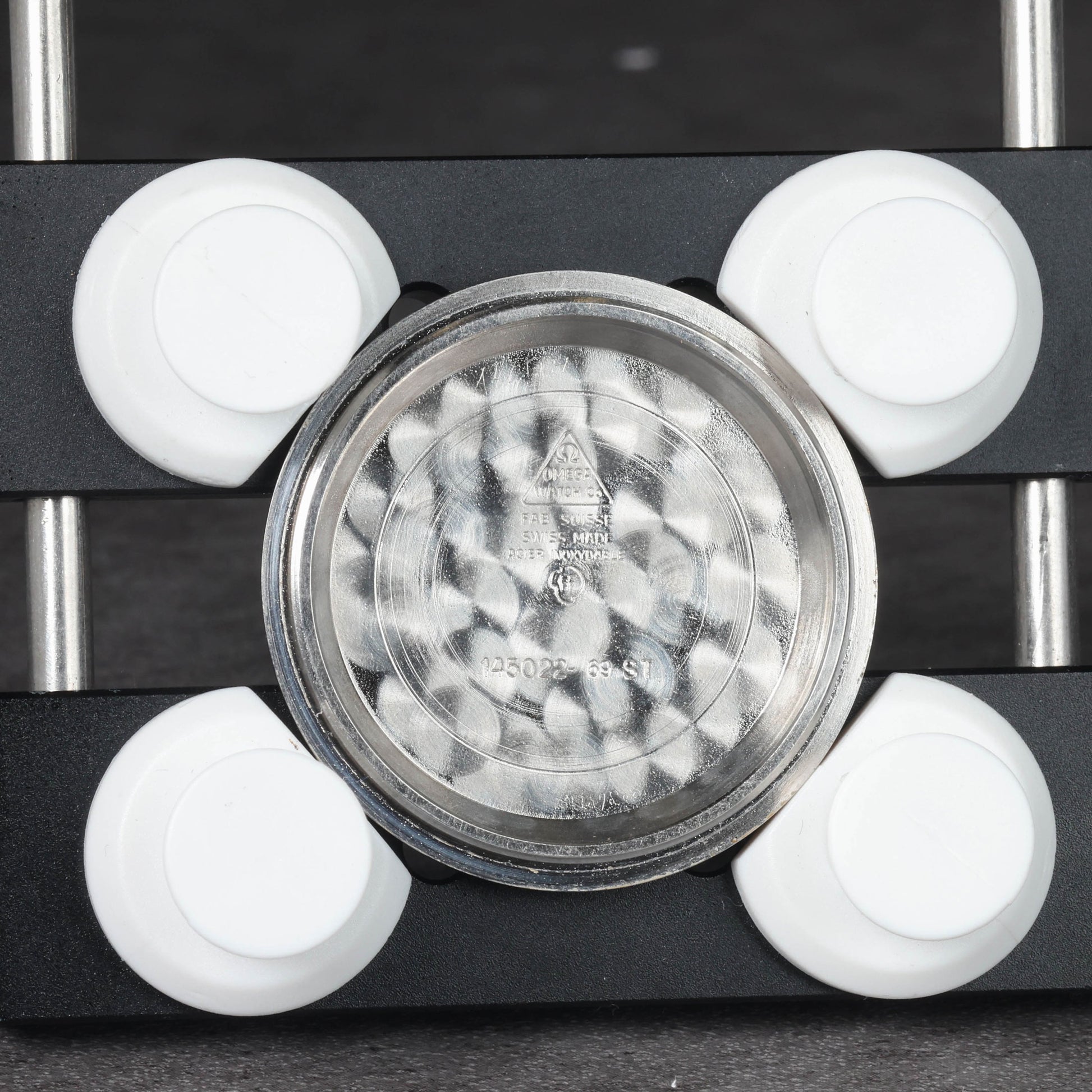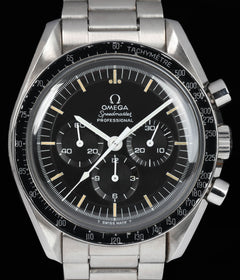Crown Vintage
Omega Speedmaster Professional 145.022-69ST "Pre-Moon" 1969 42MM
Omega Speedmaster Professional 145.022-69ST "Pre-Moon" 1969 42MM
Couldn't load pickup availability
Omega Speedmaster Professional 145.022-69ST "Pre-Moon"
Case: Stainless-steel asymmetric case in very good vintage condition with only minimal surface wear. Lugs retain sharp factory chamfers, indicating the case is likely unpolished. Seahorse case-back engraving remains crisp.
Bezel & Crystal: Original aluminium DON bezel shows light, even wear with legible numerals. Hesalite crystal clean, no major marks or distortions.
Dial: Original stepped matte-black dial in very good condition. Tritium hour markers are intact and have developed a deep, even patina. Printed text and minute track are clear, no moisture spotting.
Hands: Later Omega service hand set; lume colour is a shade lighter than the dial plots but still tritium-filled and intact. Chronograph hands reset precisely.
Movement: Calibre 861 (28-million range) not inspected here, but starts, stops and resets smoothly. Timekeeping and amplitude should be confirmed at next service.
Bracelet: Omega 1171 folded-link stainless bracelet with correct fit; light stretch and superficial hairlines consistent with careful wear. Deployant clasp snaps closed securely.
Overall: A well-preserved pre-moon Speedmaster showing honest age, complemented by a period-correct 1171 bracelet. As the watch is over 50 years old, it should be regarded as a vintage timepiece; avoid water exposure and have seals checked if regular wear is planned. No longer recommended for space flight.
Share
Why we love this watch
Why we love this watch
Omega Speedmaster 145.022-69ST Pre-Moon with DON Bezel
Introduction
Few chronographs have a back-story as intertwined with space exploration as the Omega Speedmaster Professional. Nestled between the famed 105.012 “Moonwatch” worn during Apollo 11 and the post-1971 models that gained commemorative case-back engraving, the 145.022-69 occupies a pivotal spot in the timeline. Produced from late 1968 through to around mid-1971, it represents the final “pre-moon” variant—so-called because its case-back still bears the original Seahorse motif, free of any NASA inscription. Its most recognisable external trait is the aluminium bezel with a “Dot Over Ninety” (DON) tachymeter scale, a seemingly minor detail that has become a visual shorthand for this reference.
From Trackside Timing to Flight Qualification
Omega created the Speedmaster in 1957 for timing sports-car pit crews and rally drivers. Precision, legibility, and durability guided every design decision, from the broad-arrow minute hand of the first CK 2915 to the high-contrast white-on-black dial that became a Speedmaster hallmark. In 1964 NASA began its search for a wrist-mountable chronograph capable of surviving extreme vibration, shocking temperature swings, and near-vacuum conditions. The Speedmaster passed every endurance test, earning an internal flight-qualification order in 1965—well before Buzz Aldrin stepped onto the lunar surface wearing a 105.012 in 1969. Thus, by the time the 145.022-69 entered production, the Speedmaster’s space-borne credentials were firmly established, cementing its identity as a professional timing instrument rather than a mere fashion accessory.
The Switch to Calibre 861
Earlier Speedmasters relied on Omega’s calibre 321, a column-wheel chronograph famed for silky actuation but labour-intensive to assemble. In 1968 Omega introduced calibre 861, a higher-beat lever-cam design conceived by Albert Piguet. Operating at 21,600 vph instead of 18,000, the new movement delivered improved rate stability and a simplified architecture well-suited to industrial production. The 145.022 was the first reference to receive it. Inside the -69 sub-reference sits a rhodium-plated version, calibre 861 (later designated 861-1), sporting straight-chamfered bridges, a copper-coloured finish, and an oscillating coupling clutch driven by a horizontal transfer wheel. Even today watchmakers praise its ruggedness; service parts remain plentiful, and the cam-switching system tolerates wear better than a comparable column-wheel.
The Dot Over Ninety Bezel Explained
The Speedmaster’s tachymeter bezel allows conversion of elapsed time into average speed. Prior to 1970 the bezel font placed the small lume dot for “90” directly over the numeral rather than beside it—hence “DON”. Omega quietly relocated that dot next to the number from the DNN (Dot Next to Ninety) bezel onward, most likely to improve manufacturing consistency on new tooling. Because the change aligns neatly with the shift to numbered case-backs and later dial variants, spotting a DON bezel instantly flags an earlier production window. The insert itself remains aluminium, anodised black, with painted silver numerals capable of picking up a warm grey hue after decades of sun exposure. Combined with a stepped dial and long “S” in “Speedmaster”, the bezel anchors the model’s pre-moon aesthetic.
Case Design and Proportions
The asymmetrical 42 mm case—42 mm across excluding crown and pushers—retains the twisted-lyre lugs introduced on reference 105.012. A crown-side swell protects the pump pushers from accidental knocks, while the polished bevel tracing each lug’s upper edge catches light to create a slimmer visual profile. Case thickness sits around 14 mm, providing a balanced stance on the wrist, and lug-to-lug length of roughly 48 mm keeps the watch wearable on slimmer forearms. The steel back features the Seahorse medallion and stereo-engravings “Speedmaster” and “Ω Omega”. Later production runs adopted a deeper, more pronounced stamping, but the motif remains the same. A domed hesalite crystal, complete with the tiny central Omega logo when viewed off-axis, finishes the frontal architecture and preserves the model’s authentic tool-watch character.
Dial and Hands
The dial is a matte, charcoal-black step type, meaning the central plateau sits fractionally lower than the minute track on the outer edge. This produces a subtle play of shadow under direct light, reinforcing depth without resorting to applied indices. Tritium lume blocks fill tall square markers every five minutes and taper to slim hash marks between. Over time this tritium often ages to soft biscuit or straw-yellow, a hue that harmonises with the warm-toned bezel numerals. The painted Omega logo and “Professional” script mark a departure from earlier applied metal logos, streamlining production but also reducing dial thickness—a key consideration in meeting NASA’s crystal-pressure tolerance tests. Central baton hands carry tritium-filled channels, while the chronograph seconds hand retains the spear-shaped tip introduced in the mid-60s. The sub-dial at three tracks 30-minute intervals, the nine-o’clock register counts seconds, and the six-o’clock register tallies 12 hours.
Bracelet Choices
During the-69 run, Omega supplied several bracelets to suit regional markets. The Swiss-made 1039 stretch-link bracelet, pairing 516 end-links, remains the most period-correct; its lightweight construction flexes easily and helps the head sit flat on the wrist. Later batches received reference 1171 solid-link bracelets with 633 end-links, offering increased durability for everyday wear. This watch comes with the period correct 1171/633 combination. However, whichever bracelet attached at point of sale, both feature simple folded-steel clasps stamped with the vintage “Ω” logo. Many owners today choose to alternate between the original bracelet for display and a modern fabric NATO or leather strap for daily use, preserving the period hardware while enjoying contemporary comfort.
Living in the Pre-Moon Era
Although the first lunar landing occurred in July 1969, Omega did not update the Speedmaster’s case-back engraving until 1971. References produced prior to that change—145.022-69 included—therefore straddle a curious historical moment: built after the Moon landing yet still carrying the understated Seahorse back. For enthusiasts of horological authenticity, that makes the -69 a compelling bridge between pioneering space missions and later commemorative merchandise. It showcases the matured design language that would define the Speedmaster Professional for decades—lyre-lugs, high-beat 861, stepped dial—while retaining the understated case-back originally deemed adequate for a tool watch destined for NASA cargo manifests.
Wearing Experience
On the wrist, the 145.022-69 feels distinctly purposeful. The 42 mm case wears smaller than the figure implies thanks to downward-curving lugs and the absence of bulky crown guards. At 75-80 grams on a period bracelet, weight distribution leans slightly head-heavy yet remains comfortable during extended wear. The hesalite crystal lends warmth and softens reflections compared with modern sapphire, while the cam-switch chronograph offers a positive, slightly firm pusher feel. Measured against contemporary sports watches, the -69’s proportions retain a timeless quality: large enough for legibility, restrained enough for office attire, and slender enough to slip under a cuff.
Significance in the Speedmaster Line
The 145.022-69 signalled Omega’s commitment to refining rather than reinventing the Speedmaster after NASA approval. Calibre 861 brought higher frequency and manufacturing efficiency; the DON bezel marked the end of an early design cue; and the case configuration settled into a form that persists, with minor tweaks, into current references. Subsequent models gained radial sub-dials, applied indices on re-edition variants, and sapphire crystals, yet their lineage traces straight back to the pre-moon -69. As such, this reference stands as the template for modern Speedmasters: robust, legible, and grounded in proven engineering.
Final Thoughts
The Omega Speedmaster 145.022-69 captures a unique moment when the chronograph had already journeyed beyond Earth yet had not been outwardly commemorated on its case-back. With its DON bezel, stepped dial, and calibre 861 engine, it embodies both evolutionary progress and historical continuity. For anyone seeking an archetype of the Speedmaster story—one foot in the Apollo era, the other pointing toward decades of sustained production—this pre-moon reference speaks volumes in stainless steel and hesalite.
Case & Bracelet
Case & Bracelet
- Case & bracelet in very good condition. Minimal wear visible.
- Case appears to be unpolished.
Dial & Hands
Dial & Hands
- Dial in very good condition, tritium hour markers intact with deep patina
- Hands - Service
Warranty & Condition
Warranty & Condition
Crown Vintage Watches provides a minimum 3-month mechanical warranty on pre-owned watches, from the date of purchase.
The warranty covers mechanical defects only.
The warranty does not cover damages such as scratches, finish, crystals, glass, straps (leather, fabric or rubber damage due to wear and tear), damage resulting from wear under conditions exceeding the watch manufacturer’s water resistance limitations, and damage due to physical and or accidental abuse.
Please note, water resistance is neither tested nor guaranteed.
Shipping and insurance costs for warranty returns to us must be covered by the customer. Returns must be shipped via traceable courier. Return shipment must be pre-paid and fully insured. Collect shipping will be refused. In case of loss or damages, the customer is liable.
Our Pledge
At Crown Vintage Watches, we stand by the authenticity of every product we sell. For added peace of mind, customers are welcome to have items independently authenticated at their own expense.
Condition
Due to the nature of vintage timepieces, all watches are sold as is. We will accurately describe the current condition and working order of all watches we sell to the best of our ability.
Shipping & Refund
Shipping & Refund
